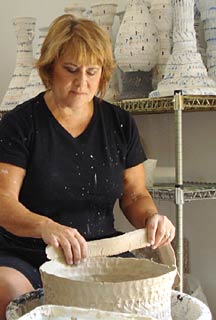Scale in the architectural environment
has always fascinated me. I began my career as an
advertising art director, including billboards, in image
driven Los Angeles. Since 1977, I have created site
specific, publicly placed paintings and sculpture for major
private and public sector institutions. With a degree in
History from UCLA, my focus was on the role of location and
connections between the past and contemporary society, often
reflecting my heritage as a fourth generation Californian.
My first interests were in abstracted architecture, but with
my Amelia Earhart mural in 1991, the human figure and how
people relate to each other fascinated me. In both my public
and private work, I thought of myself as a visual historian,
both representational and as narrative. Since returning to
Sacramento in 1984, I have maintained a consistent solo and
group exhibition schedule.
Increasingly, my work has come off the
wall, starting with murals at Jack London Square in Oakland,
1996. I needed to compel people to become more engaged in
the murals so I added ceramic elements to the 2D mural.
Viewer engagement is a driving impetus in my work. Curiosity
also drives me, and I want to inspire this in the viewer as
well.
 In
2003, stepping out of my comfort zone, I returned to school
to study art full time. I had been a Philosophy major at
UCLA for a time, and with a pivotal trip to London that
year, a renewed interest in theory flared. I spent the next
three years focusing on issues and practice, making objects
and exploring my personal response to the world, independent
of representation.
In
2003, stepping out of my comfort zone, I returned to school
to study art full time. I had been a Philosophy major at
UCLA for a time, and with a pivotal trip to London that
year, a renewed interest in theory flared. I spent the next
three years focusing on issues and practice, making objects
and exploring my personal response to the world, independent
of representation.
The idea of beauty now seems
increasingly worthy of pursuit in our contemporary world.
Iíve been able to acknowledge a deep appreciation for both
design and my obligation as an artist in an increasingly
threateningly global, postmodern world. It has taken me
beyond narrative representation into a world where I can
create my own fantasy, in more expressive materials, from
clay to steel. It has also reminded me of my keen interest
in environmental issues which began in 1994 with my first
recycled and found object sculpture.